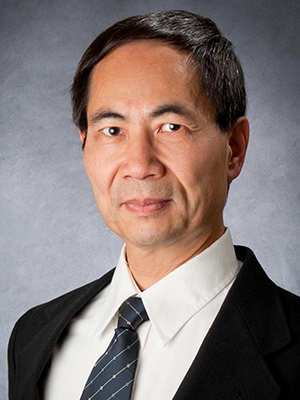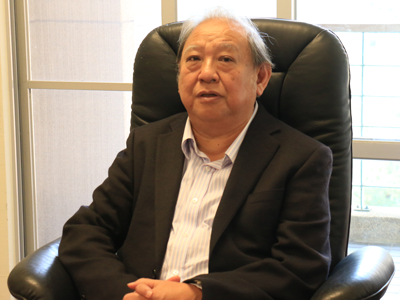
Kang-Lung Wang 王康隆院士
Distinguished Professor and Raytheon Chair Professor
Departments of ECE, Physics and Astronomy, and MSE
University of California
Why should we care about Topological Quantum Computer?
Today’s computer has changed our world and social behavior since last century. These computers use 0 and 1 to perform computing in a sequential manner as implemented in semiconductor technology. However the computing performance has slowed down due to energy dissipation as the scaling of the size approaches the physical limit. Quantum computer potentially offers a drastically different way of computing problems in a massively parallel using quantum bits (qubits), for which the qubits are entangled in the sense that 1 and 0 could not be taken apart. The entanglement needs to maintain phase coherence, which is the key challenge for realization and in scaling up the number of qubits in quantum computing. Topological protection of the qubits can markedly increase the coherence of entanglement and thus make possible scaling of qubits for solving many unsolvable problems to date, including drug discovery, and anticipation and prevention of natural disasters, e.g., earthquakes. By reducing 3 dimensional systems to two dimensions using Majorana particles as qubits, such topological quantum computer may be realized. In 1937, Ettore Majorana proposed a particle being its antiparticle. Since its inception, Majorana has been under intensive pursuit both theoretically and in experiments. Recent interest in robust topologically protected quantum computing has accelerated the experimental quest of Majorana.
The talk will discuss the experimental efforts in search of Majorana. I will discuss a key physics and material to realize dissipationless transport: quantum Hall without magnetic field, quantum spin Hall to quantum anomalous Hall (QAH); it was enabled by a long term effort in the materials growth of topological insulator. The use of QAH is of critical importance as the dissipationless edge state of QAH offers a long coherent length in mm length scales; this is the key for scaling to a large number of quantum bits. When the QAH edge states interface with a superconductor, the Dirac electron space is transformed to the Nambu space, hosting Majorana fermions via pairing energy of the superconductor. Our recent experimental results show the convincing evidence of the half-integer quantized conductance plateau (0.5 e2/h) for the one-dimensional chiral Majorana fermion at the proper topological phase transitions using a QAH/superconductor heterostructure. This half-integer quantized conductance plateau (0.5 e2/h) gives a firm signature of the elusive Majorana fermion for the first time. More recently, the half-integer quantized conductance was also realized in a similar InSb nanowire and a superconductor heterostructure. Our finding offers a new direction for robust topological quantum computing to minimize the de-coherence challenge. I will discuss several possible pathways for realizing the elemental qubits and operations. One of these approaches is to pattern a 2-dimensional structure into nanowires, which make the Majorana Chiral modes into zero modes, for which quantum bits may be coded.

Tai-Chang Chiang 江台章院士
Department of Physics
University of Illinois at Urbana-Champaign
Novel Electronic Properties of Single Layers and Ultrathin Film Systems
The electronic and physical structures of ultrathin films can be markedly different from the bulk counterparts, leading to unusual and unexpected properties and effects. This talk will review several cases involving transition metal dichalcogenides MX2 and topological insulators M2X3 that can be readily prepared in robust few-layer forms by molecular beam epitaxial growth. Their properties of interest include charge density waves, Weyl Fermions, topological electronic stats, superconductivity, etc. We examine how these properties evolve with the electronic structure as the material is made thinner and thinner, down to the single-layer limit. A few highlights will be presented. For TiSe2, its charge density wave transition at 205 K in the bulk moves up to 232 K in the single layer. By contrast, TiTe2, a closely related material, shows a charge density wave transition at 92 K in the single layer, but not in two, three, … layers and in the bulk. The very different behavior is puzzling and challenges the prevailing wisdom. Another example is a thin film of the topological insulator Bi2Se3 prepared on an s-wave superconductor Nb. The topological surface states of the Bi2Se3 film exhibit an induced paring gap; evidence for p-wave paring possibly indicates novel topological superconductivity. The big picture is that ultrathin films represent a rich research frontier crucial to the continuing development of materials science and technology.

Chung-Yuan Mou 牟中原院士
Department of Chemistry
National Taiwan University
Nanoporous Materials for Applications
Mesoporous silica offers promising possibilities for many applications, including biomedicine, catalysis, and adsorption. This talk reviews recent developments in the synthesis and applications of mesoporous silica from my laboratory at National Taiwan University. I will discuss the control of morphology(thin film, nanoparticle and hollow spherical) and surface functionalization in synthesis.
1). Biomedical applications of nanoparticles: Research into the rational delivery and targeting of pharmaceutical, therapeutic, and diagnostic agents is at the forefront of nanomedicine. We are developing mesoporous silica nanoparticle(MSN) as a multifunctional vehicle for the purpose because its mesopores can carry high loadings of protected proteins and drugs for therapeutic delivery. In a bio-inspired approach, encapsulating enzymes in mesoporous silica nanocarriers to create an optimal nanospace mimicking intracellular organelles will be discussed. We present approaches of delivering MSN and hollow silica nanospheres with encapsulated cargos into biological cells for biological functions of catalysis or sensing.
2). Large Area silica thin films(MSTF) with vertical orientation of pores were synthesized in free-standing and supported form. Their formation mechanism was studied by TEM, SEM, GISAX, in-situ SAXS and SANS. In free standing form, SBA-15 of micron-size and ~100 nm thickness was made. The formation of the film is a result of the confinement effects of a silica deposition vesicle and silica transport vesicle which is much in analogy to the formation of the silica frustule of diatom. After surface functionalization, large amount of AuCl4- ions can be adsorbed and chemical reduced on top of the MSTF. A hexagonal 2-D array of gold nanoparticles, in wafer size, can be produced. Strong SERS effect was demonstrated on the two-dimensional gold nanoparticle array. The SERS effect is due to large amount of hot spots developed in the narrow gap(~ 1 nm) in the array.